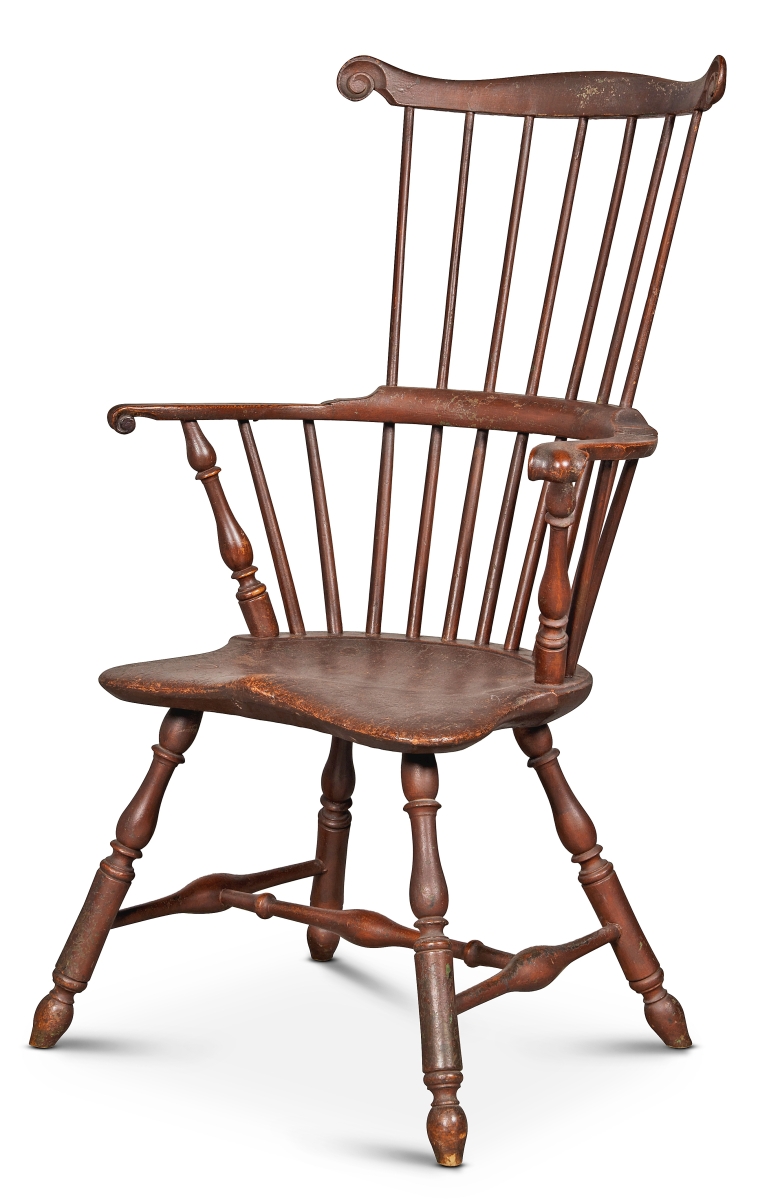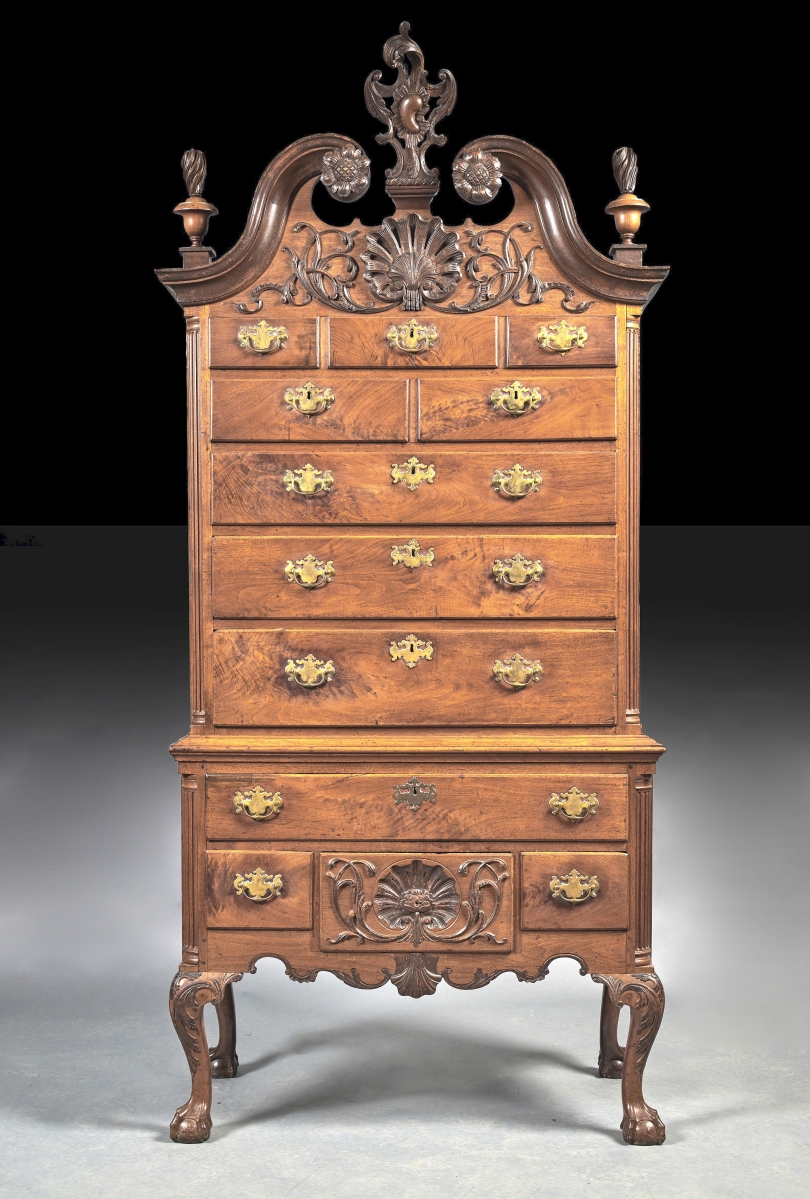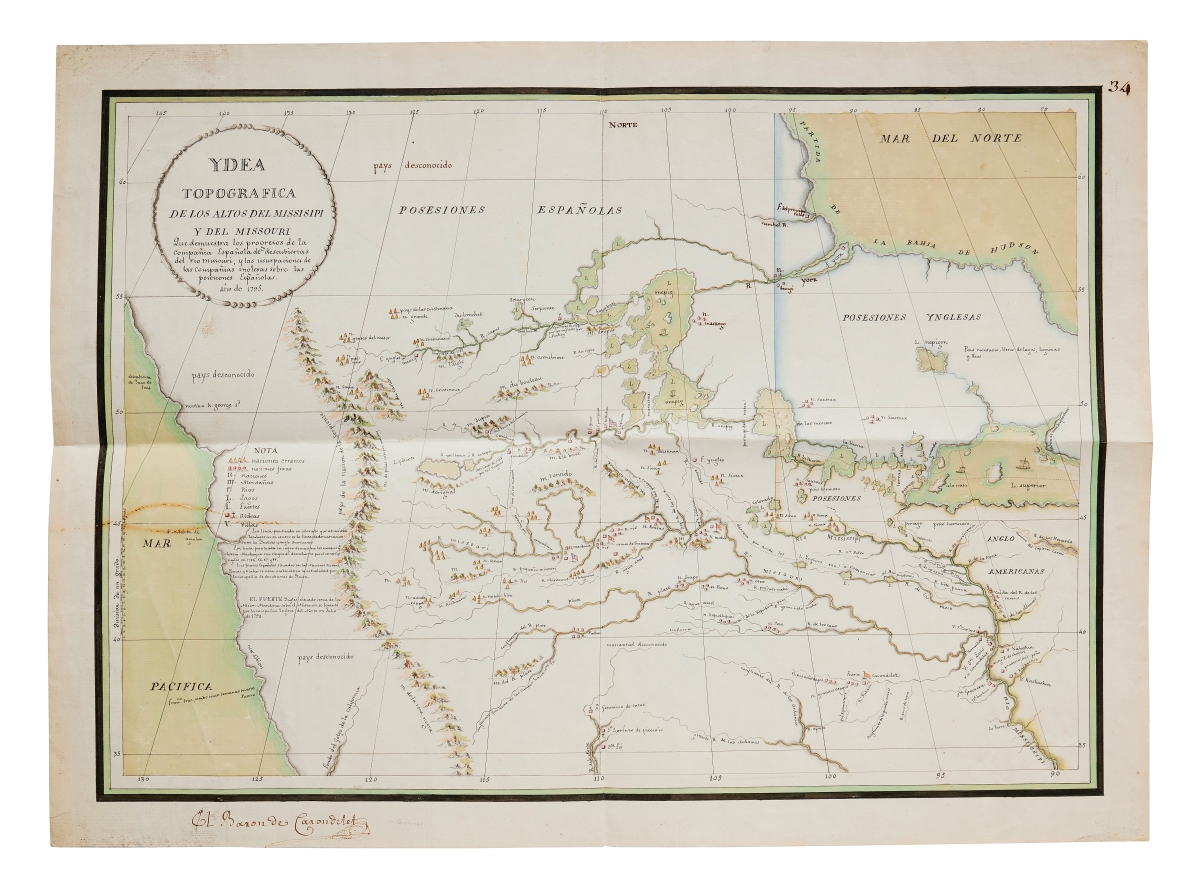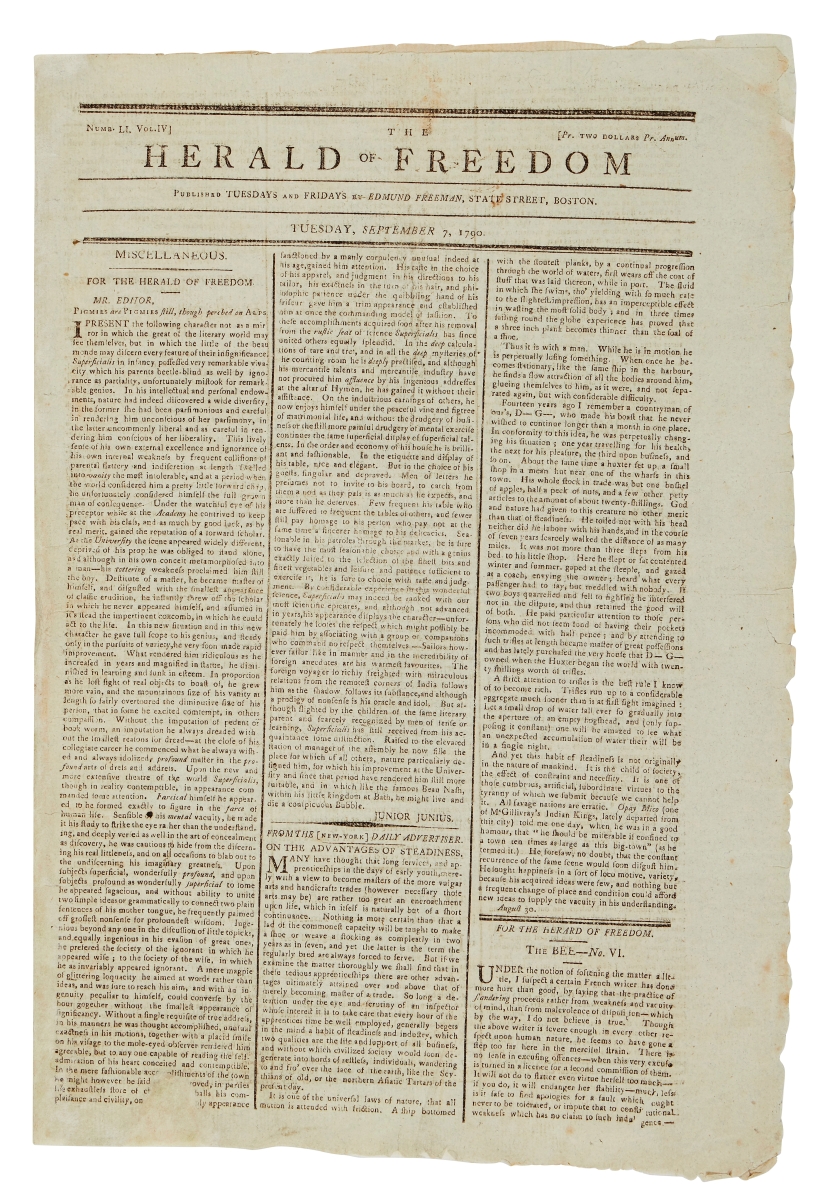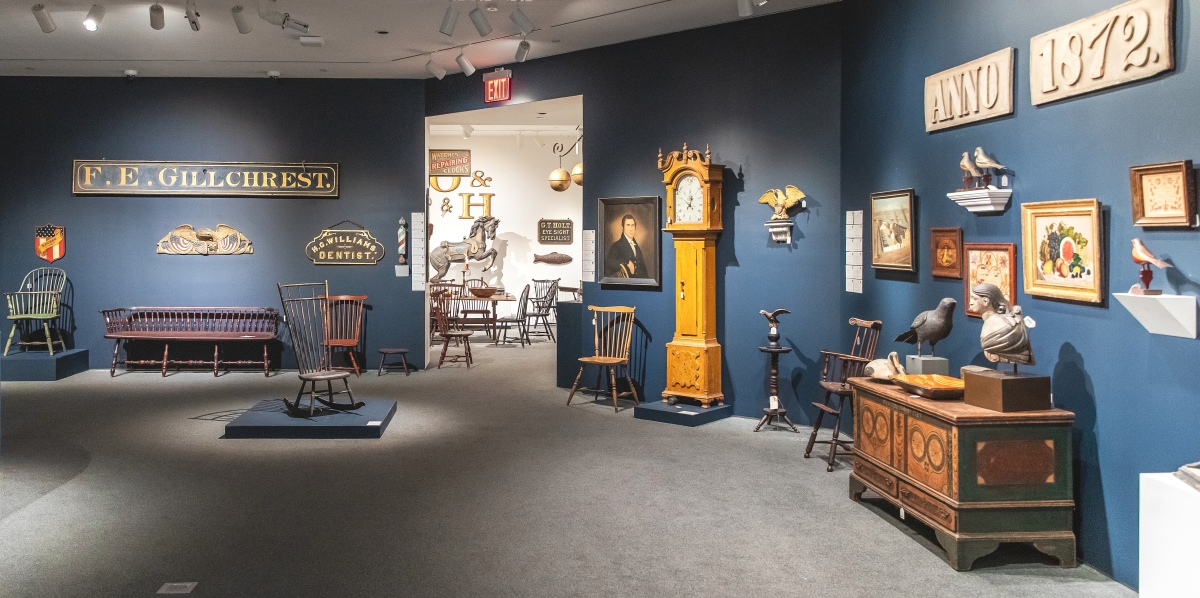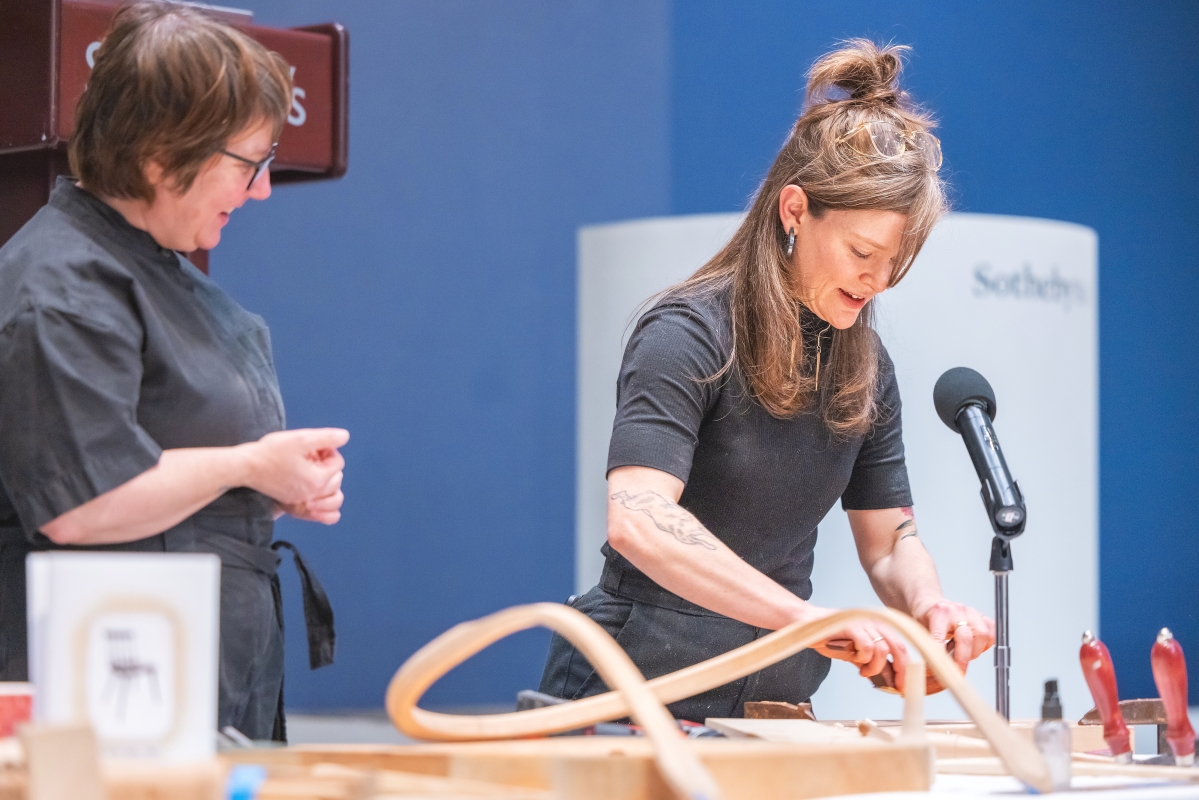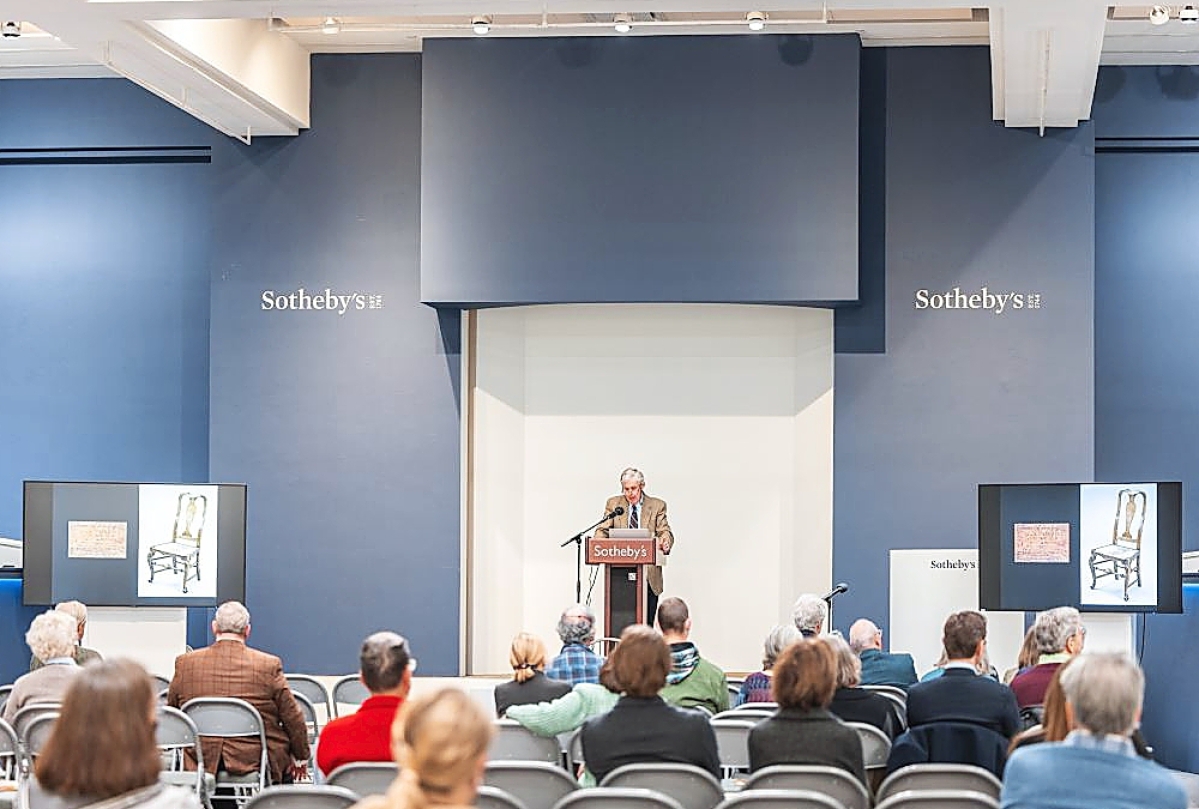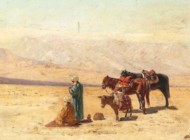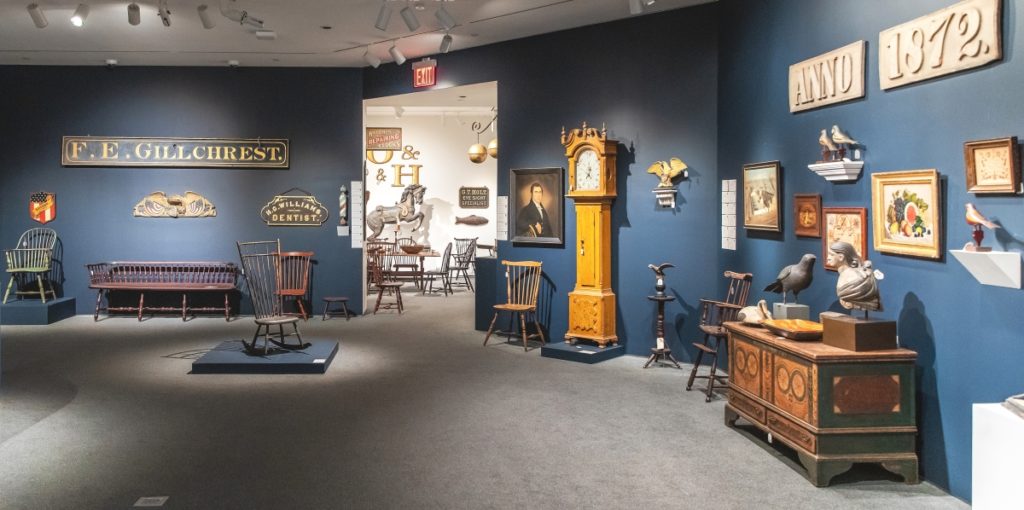
The collection of Charles and Olenka Santore on view prior to the auction.
Review by Madelia Hickman Ring, Photos Courtesy Sotheby’s
NEW YORK CITY – In pre-pandemic years, Americana Week was largely the province of the American furniture and folk art department, with contributions from Chinese export, silver and prints. It was not unusual for several items to sell in the seven-figure range with a typical yield for the auction house easily reaching low eight figures from packed auction rooms and banks of phone bidders.
That vision contrasts with the most recent Americana Week, which saw significantly more bidders participating online and salesroom audiences shrinking. Now, to reach the auction totals the auction house expects, the focus of the week has expanded. Americana Week has evolved into a more-inclusive one, in which additional departments – fine art, books and manuscripts and Native American art – joined the firm’s conventional January offerings; an “E Pluribus Unum” model if you will. During January 18-24, a total of 1,175 lots crossed the block for a cumulative total of $14,974,567 compared to the aggregate spread of $17.8/26.7 million, and an 83 percent sell through overall.
Art of the Americas
January 18 saw nearly 50 lots of Nineteenth and Twentieth Century historical paintings, drawings and sculpture by some of the canon’s marquee names: Albert Bierstadt, Winslow Homer, Frederic Remington and John James Audubon. Property came from a Canadian private collection, the estate of Benjamin D. Holt Jr, and property from the Philadelphia Montessori Charter School, among other anonymous sellers. The sale had presale expectations of $5.6/8.3 million and earned $4.5 million, with more than 70 percent of the lots trading hands successfully.
“It was our first iteration of the concept, and part of a larger strategy with our other categories, to offer Nineteenth and some of the historically minded works in January,” said Elizabeth Goodridge, Sotheby’s assistant vice president in American Art. “It allows us to benefit from the cross-promotion with Americana collectors; it was quite a success.” She noted that the sale attracted new bidders as well as some of the department’s usual clients, with private collectors taking many of the sale’s top lots.

“Mountain Out of the Mist” by Albert Bierstadt, circa 1889, oil on canvas, 26¼ by 36 inches, is included in the Albert Bierstadt catalogue raisonné project and was accompanied by a letter of opinion from Melissa Webster Speidel, president of the Bierstadt Foundation and director of the Albert Bierstadt catalogue raisonné project. It found a new home with a private collector for $428,400 ($300/500,000).
It is entirely appropriate that the top lot of the American art sale was John James Audubon’s (1785-1851) “White-Headed Eagle,” which sold for $756,000 and a new world auction record for an oil painting by the artist. Painted circa 1828, the catalog listed an extensive provenance that went back to 1840, when it was acquired directly from the artist.
Hudson River School paintings continue to have lasting appeal among collectors in the category, with a second place finish at $491,400 – and the third highest price ever realized at auction for a work by the artist – which a private collector paid for Asher Brown Durand’s (1796-1886) expansive landscape, “Lake Hamlet (Passing Shower).” One of the pieces from the Canadian private collection, the landscape had been painted in 1855; its history included the corporate collection of American Express as well as Berry-Hill Galleries in New York City.
Another vast landscape – this time of the Rocky Mountains – also finished within estimate, at $428,400. “Mountain Out of the Mist” by Albert Bierstadt (1830-1902), which was painted circa 1889. Executed on a comparatively diminutive scale at 26¼ by 36 inches, the painting combined the artist’s technical training and his affinity for the outdoors.
A private collector paid the same price of $428,400 for “Broncho Buster,” which the catalog describes as “Frederic Remington’s first and most popular sculpture.” Cast during Remington’s (1861-1909) lifetime at the Henry-Bonnard Bronze Co foundry in New York City, it numbered 49 from an edition of 64 and had provenance to a private Louisville, Ky., collection that had owned it since it was cast.
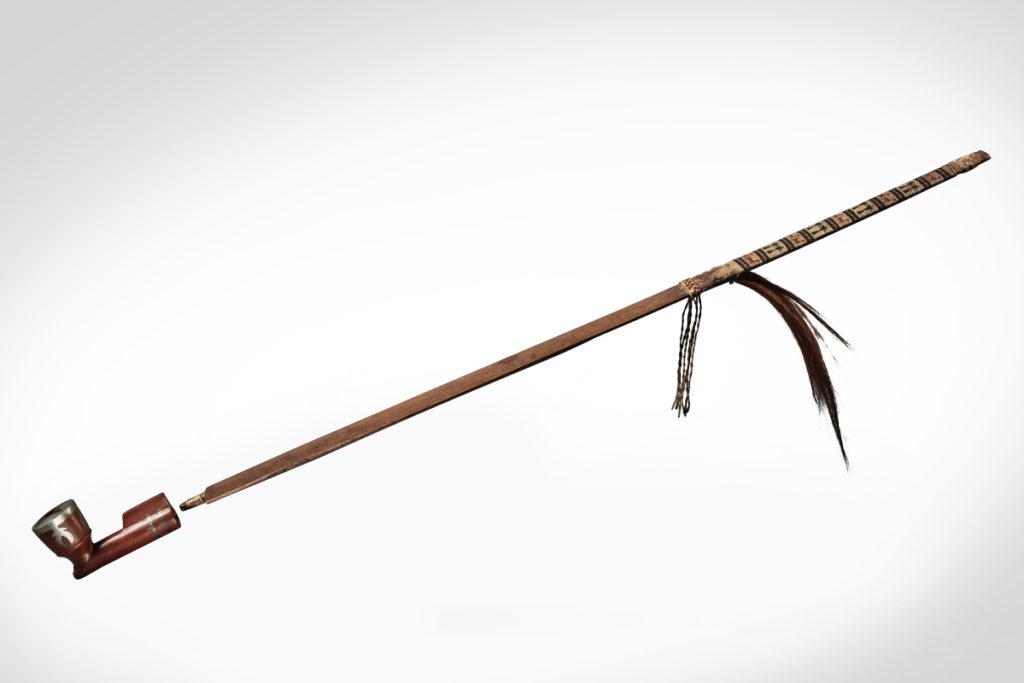
This Dakota ceremonial pipe and stem sold for $108,000; it was the highest price realized in the American Indian Art sale ($100/150,000).
American Indian Art
A live sale of 75 lots of Native American art on January 18 marked the first time since 2015 that Sotheby’s had offered a various owners’ auction in this category; selections from the collection of composer Elliot Lawrence were highlighted. Closing with a total of $860,580 against presale expectations of approximately $700,000-$1 million, the sale saw more than 73 percent of lots trading successfully.
The lot with the highest estimate – $100/150,000 – also set the apex of the sale, at $100,800. A Dakota ceremonial pipe and stem, measuring 41-3/8 inches, went the distance and had provenance to a Nineteenth Century Shropshire, UK, collection, as well as a Sotheby’s sale in 1994. A private collector, who acquired it in 2008 from a Santa Fe, N.M., dealer, was the seller; the buyer was not disclosed.
An exceptional result of $94,500, more than three times its low estimate, was achieved for a Wukchumni Yokuts friendship basket attributed to Mary Dick Toping (1863/1868-1923), who was also known as “Mrs Britches.” Described in the catalog as a “masterpiece of California basketry,” the 17-inch diameter basket was decorated both inside and out by two chains of alternating male and female figures below a band of silhouetted bears below the rim. Additionally, it had been illustrated in Wayne A. Thompson and Eugene S. Meieran’s, California Indian Basketry: Ikons of the Florescence (San Diego, 2021).
Also exceeding expectations – this time by more than 10 times its low estimate – was a Punuk walrus ivory bucket handle, circa 800-1400 CE, which bidders took to $50,400 from an estimate of $5/7,000. Interest in the early piece, which was from the Lawrence collection, was no doubt improved from it having been illustrated in two books on artifacts from the Bering Strait, as well as being exhibited in two exhibitions, including one that took it to Anchorage, Alaska, Berkeley, Calif., Detroit, Mich., and New York City.
After the sale, Alexander Grogan, department head for Art of Africa, Oceania and the Americas, said, “We are pleased to have successfully reintroduced the American Indian Art sale this January, timed to coincide with Americana Week. [We] saw a depth of bidding that led to record prices and competition from both seasoned American Indian art collectors and those new to the category.”
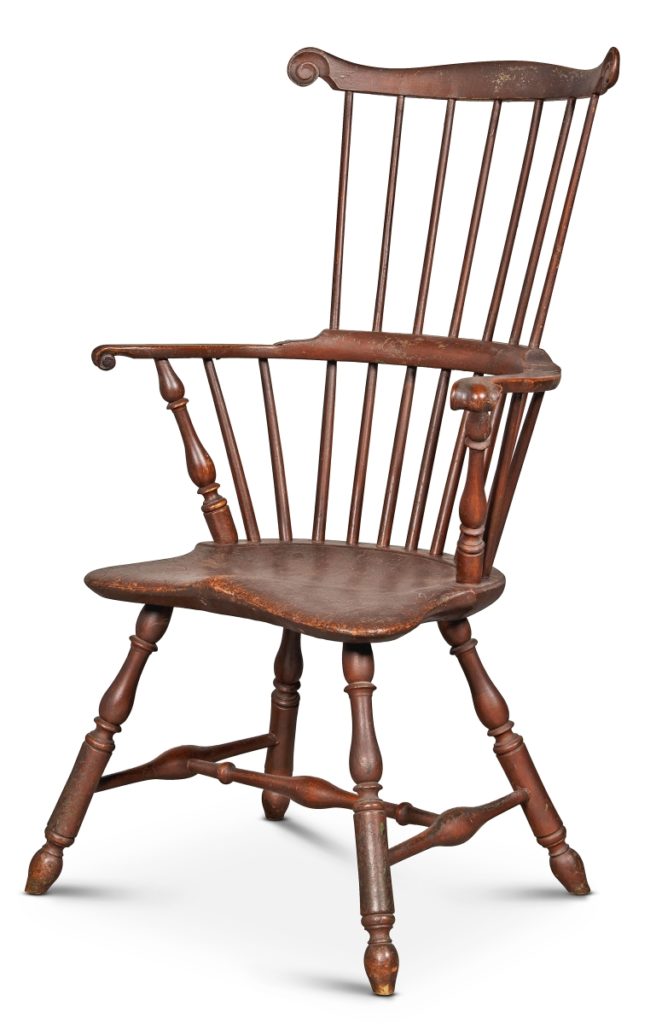
Clearing its $200/300,000 estimate with more bidders than expected and selling to an “important private collector” bidding on the phone for $378,000 was this Philadelphia brown-painted scroll-carved comb-back Windsor armchair that led the Santore collection.
Important Americana: The Charles and Olenka Santore Collection
Sotheby’s has a long tradition of hosting single-owner auctions during Americana Week; the house repeated the practice this year with two. The first to sell was that of Windsor connoisseur, collector, dealer, and illustrator Charles Santore, in which more than 350 lots of painted furniture, folk art and objects were offered, most without reserves. Nearly 98 percent of the lots sold in the single-day auction on January 19, finishing with a sale total of $1.9 million against presale expectations of $1.3/2.1 million.
The star lot – and one of at least two record-breaking lots in the sale – was a reddish-brown-painted scroll-carved comb-back knuckled Windsor armchair from Philadelphia, circa 1775, that sold on the phone for $378,000 and a new world record for any Windsor chair sold at auction. The result may not be too surprising considering the chair had graced the cover of Santore’s indispensable tome, The Windsor Style in America: Volume II, A Continuing Pictorial Study of the History and Regional Characteristics of the Most Popular Furniture Form of Eighteenth-Century America, 1730-1830 (Philadelphia, 1987). It was purchased by a phone bidder who department head Erik Gronning categorized as “an important private collector”; it was underbid by Patrick Bell of Olde Hope bidding in the room.
Bell also purchased a bowback Windsor chair, two Virginville pottery birds and a Connecticut Windsor candlestand, as well as some accessories.
Swimming to a strong finish at $138,600 – and second place overall – was a Moravian glazed red earthenware fish flask, attributed to Rudolph Christ of Salem, N.C., circa 1801-25. Of a nice large size at 9¾ inches in length, the piece was denoted by crisp decoration of the fins, scales and eyes, as well as lavish copper and manganese glazes over the yellow clay ground. It sold on the phone to a bidder with associate specialist, Caroline Tamposi, underbid by another bidder on a phone with Gronning.

This George II silver cup and cover, made in London in 1748, but presented to Captain Joseph Hamar (circa 1712-1773) for his services during King George’s War when Hamar was sailing various ships out of Port Royal, S.C. (1744-48). It will be returning to South Carolina, acquired by Historic Beaufort Foundation after robust competition for $56,700 ($15/25,000).
After the auction, Antiques and The Arts Weekly reached out to ceramics expert, editor and consultant, Rob Hunter, who confirmed that the price was a new auction record for any Moravian bottle, besting the previous record of $100,000, which was set at Mebane Antique Auction in 2009, for a Moravian turtle flask.
Gronning said the $100,800 a private collector paid for a pair of portraits of Herman Miller and his wife, Carson Dana Gifford Miller, that were attributed to Amanda Powers, is also a record for the artist, whose work “rarely” comes to market. Done in oil on artists board measuring 18 by 14 inches, the portraits had been in the collection of the Strong Museum of Play in Rochester, N.Y., before selling at Cottone Auctions in 2014, where they had been sold as attributed to Asahel Powers, seemingly a relative of Amanda’s.
“That was by far a record,” Gronning remarked about the $71,820 achieved for a carved and gilt polychrome paint-decorated pine spread-wing eagle wall plaque, attributed to W.H. Beal and dated 1888, that is nearly identical to one signed by Beal in the collection of Winterthur Museum. It sold to Pennsylvania dealer Jeff Bridgman, for stock.
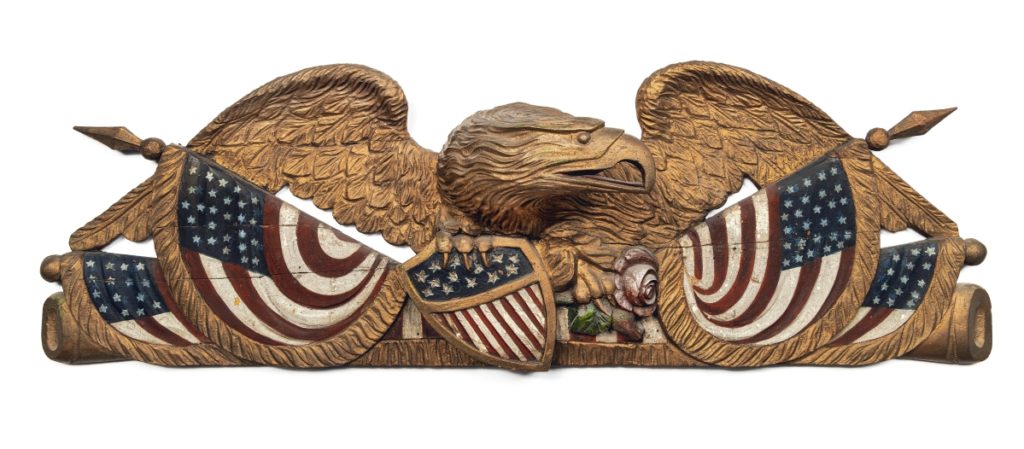
“I just love it. I think it’s an incredible thing and I was extremely pleased to get it,” said dealer Jeff Bridgman, who paid $71,280 for this dated 1888 carved and gilt polychrome paint-decorated pine spread-wing eagle wall plaque. It was attributed to W.H. Beal and was one of the top lots in the Santore collection ($15/25,000).
If the estimates were a guideline, there were several unexpectedly strong results, including a child’s black-painted sack-back Windsor armchair from Philadelphia, circa 1770, that Santore had featured in his first volume, The Windsor Style in America: A Pictorial Study of the History and Regional Characteristics of the Most Popular Furniture Form of Eighteenth-Century America, 1730-1830, (Philadelphia, 1981) that interest pushed to $17,640, more than twice its high estimate. Flying to $12,600 was a painted wooden seagull ($600-$1,000), while a final price of $10,710 obliterated the $300/500 estimate for Daniel Otto’s (1770-1822) “Four Crowns of Love” fraktur, circa 1805.
In addition to buying several fraktur and trade signs, dealer and director of Historic Trappe, Lisa Minardi, purchased for a client a Berks County painted chest made for Catharine Kelchner [misinterpreted as Reichner in the catalog], which she described as “a beautiful example of this group, made even more special with remnants of early fraktur pasted inside the lid with inscriptions that confirm the identity of the original owner.”
When asked if the family was pleased, Gronning said he’d received “very happy emails” from them after the sale.

The stunning original rooster cartouche was just one of the spectacular elements of this Philadelphia Chippendale tall case clock, which topped the Kindig sale at $132,300 and sold to Jim Kilvington bidding on the phone for a client ($30/50,000).
The Kindig Collection: Important American Furniture, Paintings, Silver & Decorative Arts
If the Santore collection was largely unreserved, many of the higher-valued items in the Kindig collection had reserves; it tallied $1.45 million against presale expectations of $1.3/2.0 million and was nearly 86 percent sold, by lot.
The top lot in the Kindig sale saw an exceptional result of $132,300 for a Chippendale carved and figured mahogany tall case clock, the works by Frederick Maus (active 1785-93), the case attributed to George Pickering (d 1784); it retained not only its original finials but an unusual rooster cartouche. It had been cited as a “best” example by Albert Sack in Fine Points of Furniture (New York, 1950) and sold to Delaware dealer Jim Kilvington on the phone, bidding for a client, significantly ahead of its $30/50,000 estimate.
Kilvington also paid $60,480 for the second highest priced lot in the sale, a Chippendale carved mahogany scalloped-top tilt-top tea table, the carving attributed to Nicholas Bernard (1732-1789), Philadelphia, circa 1750. Notable features in addition to its early date was the retention of its original surface and casters.
Furniture and clock dealer, Gary Sullivan, who was outbid on the Maus-Pickering clock before he could raise his paddle, called it “a spectacular example.” He was the successful bidder on a few other things in the Kindig sale, including the circa 1770 James Read Chippendale carved and figured mahogany dressing table, the carving attributed to James Reynolds, Philadelphia, which was published by Morrison Heckscher in American Furniture in The Metropolitan Museum of Art, Vol. 1, (New York, 1985), as well as, for $23,940, a Chippendale block-and-shell carved mahogany tall case clock, Newport, R.I., circa 1775, that relates closely to an example in the collection at Yale University and illustrated in Edwin Battison and Patricia Kane’s, The American Clock, 1725-1865 (Greenwich, Conn., 1973).
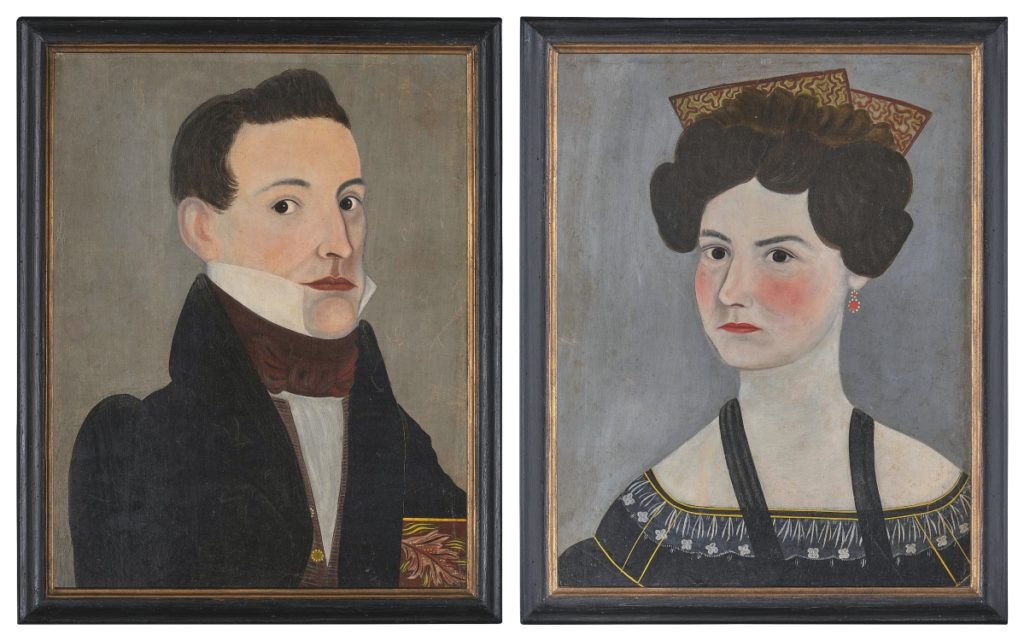
This pair of portraits of Herman Miller and his wife, Carson Dana Gifford Miller, attributed to Vermont artist, Amanda Powers, set a new world auction record for the artist, bringing $100,800 from a private collector. Santore collection ($12/18,000).
A set of four Chippendale side chairs, attributed to James Gillingham (1736-1781) of Philadelphia, all but tripled the low estimate and sold for $44,100 to Skip Chalfant, bidding on the phone with Erik Gronning on behalf of a client. The set had been published by Joseph K. Kindig, III in The Philadelphia Chair, 1685-1785, (York, Penn., 1978).
Bidding on behalf of Historic Trappe, Minardi paid $10,710 for a 17-page fraktur book made by schoolmaster Samuel Musselman and dated 1816. The book, which Musselman may have used to show pages to prospective clients, provides a rare, behind-the-scenes glimpse into the making of fraktur and includes both highly ornate pages that showcase his incredible talent as well as pages of plainer text, the German Fraktur alphabet, and samples of bookplates that serve as a visual record of his work.
Minardi also bought, both for clients and stock, several other fraktur, some needlework and other textiles, an iron stove plate and a William and Mary inlaid walnut blanket chest dated 1767. For her own collection, she purchased a Chippendale carved walnut high chest, from Lancaster, Penn., circa 1775.
Seated alongside Minardi in the salesroom was Tom Stokes, a budding scholar who recently assisted her in launching Historic Trappe’s new loan exhibition of furniture from the Dietrich American Foundation (see cover story, Antiques and The Arts Weekly, January 20). Stokes claims family ties to the Muhlenberg family as well as the Kindig family. He reported buying two brass tobacco boxes, a side chair, a desk, and an easy chair that had belonged to one of his colonial ancestors.

Of the five print lots in the online Americana sale, the first on offer, which also brought the highest price, was “Trumpeter Swan,” a hand-colored aquatint, engraving and etching by R. Havell, after John James Audubon, on J. Whatman 1838 watermarked paper, that closed at $18,900 ($15/25,000).
Important Americana
A year ago, in January 2022, Sotheby’s created a new format for its various owners’ furniture, folk art, prints, silver and Chinese export lots: a small boutique auction of some of the more exceptional pieces on offer, with the bulk going into a timed online auction. That was the strategy again this year, and 74 lots crossed the block on Monday morning, January 23. The sale featured lots from the Robert L. McNeil Jr Trust; lots from the William K. DuPont’s collection at Rocky Hill, the New-York Historical Society, and property that had descended in the deWitt and Adams families. A total of $1.86 million was realized, just 50 percent of the low estimate, with just 50 percent of lots selling.
Topping its estimate and earning top-lot honors at $277,200 was the Mrs J. Insley Blair Chippendale carved and figured walnut scroll-top high chest of drawers, case attributed to Henry Clifton (circa 1725-1771) and Thomas Carteret (active 1753-65), the carving attributed to the “Spike” carver, made in Philadelphia, circa 1760. It was being sold by the New-York Historical Society and had been published by Luke Vincent Lockwood, Robert William Glenroie Vail and Helen Comstock. It was recognized as being one of the best-preserved examples of its form, retaining its original cartouche, finials, rosettes, applied carved elements and cast brass hardware. Underbid by Connecticut dealer David Schorsch, it was purchased for a client by furniture scholar and consultant Alan Miller, who has done extensive research on the carver.
Miller also purchased the second highest lot in the sale, the Francis P. Garvan Chippendale carved and figured walnut bonnet-top high chest of drawers, carving attributed to Nicholas Bernard (1732-1789), Philadelphia, circa 1755-60. Earning $189,000, the high chest was described in the catalog as making “a monumental statement of the Philadelphia aesthetic” and came with not only an extensive provenance but also detailed publication and exhibition history.
A pair of Classical carved mahogany harp-back klismos side chairs, attributed to New York City cabinetmaker Duncan Phyfe, circa 1815, soared above expectations and sold to a private collector for $176,400, the third highest tally of the session. The chairs’ design was described by Albert Sack in The New Fine Points of Furniture Early American (New York, 1993) as “the symmetry achieved by integrating the asymmetrical harp into a conventional frame is a brilliant achievement,” which the catalog also characterized as the apex of seating furniture design in New York in the Neoclassical period. Though there are nearly a dozen other chairs, the pair had been originally purchased by William Radcliffe deWitt DD (1792-1867) and Mary Eleanor Wallace (1807-1881 and had remained in the deWitt family until they were offered at Sotheby’s.
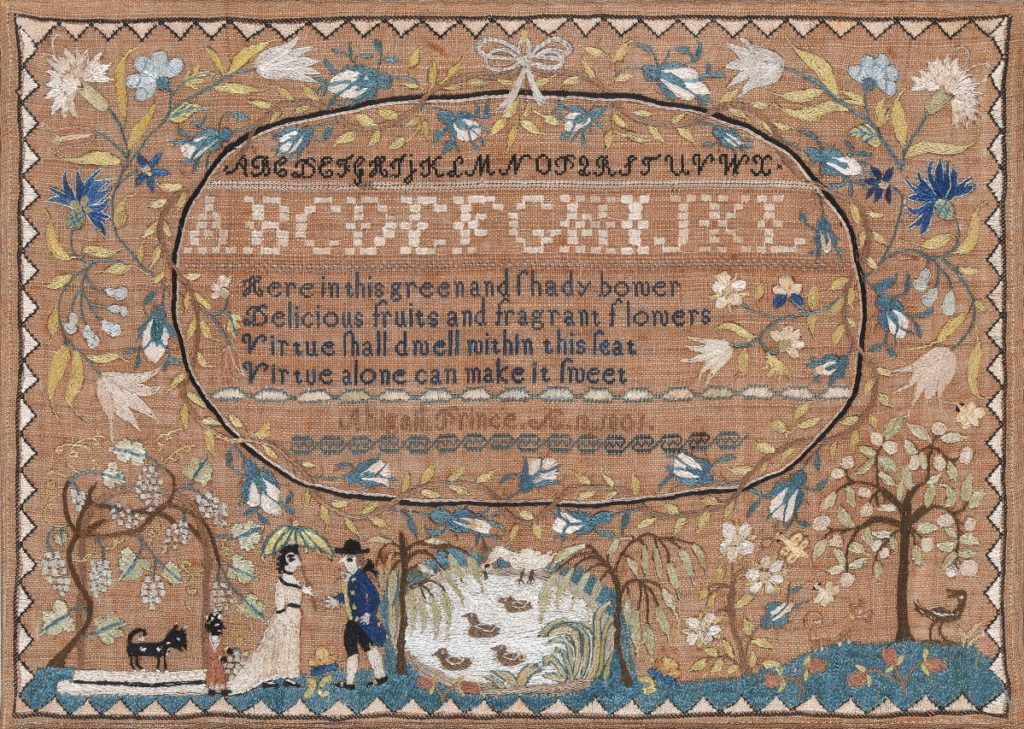
Gary Sergeant paid $63,000 for this silk embroidered sampler that had been wrought by Abigail Prince in Newburyport, Mass., in 1801. Important Americana ($60/80,000).
Furniture was not the only high-flyer in the sale – an alkaline-glazed stoneware and kaolin clay face jug, made in the Edgefield district of South Carolina circa 1867-85, finished at $88,200. Edgefield pottery has been the subject of recent scholarship, including the recently closed Metropolitan Museum exhibition, “Hear Me Now: The Black Potters of Old Edgefield, South Carolina.” Though he was outbid before he could enter the online bidding fray, Rob Hunter said he was glad to see it sold so well.
Sand bottles by Andrew Clemens (1857-1894) of McGregor, Iowa, have made antiques-world headlines when several have sold for high six figures at other auction houses in recent years. The example Sotheby’s offered depicted an American paddlewheel steamship and roses and was inscribed “Pictured Rock Sand” with the initials “HTS” and dated 1885. It sold to a private collector for $81,900, within estimate.
Woodbury, Conn., dealer Gary Sergeant, picked up several things, including, for $63,000, a silk embroidered sampler, worked in 1801 by Abigail Prince of Newburyport, Mass. The seller had acquired it in 2012, when Sotheby’s offered the collection of sampler dealer, Betty Ring.
Minardi was also a successful bidder on two lots in the Important Americana sale, both for her own collection. One was a pair of Queen Anne carved and figured walnut compass-seat side chairs for $6,930. The chairs had intaglio knees and were made in the same shop that made an armchair she owns that her late husband, Philip Bradley, inherited from his father. She also purchased, for $27,720 a Pennsylvania German walnut stepback cupboard from the late Bill du Pont’s collection, which she remembered had been a favorite piece in his kitchen.
Institutions were at play in the sale, including Historic Beaufort Foundation of Beaufort, S.C., which acquired for $56,700, against strong competition, a George II silver presentation cup and cover of South Carolina interest and inscribed “The Gentlemen of Port Royal / So: Carolina / Present this Plate to Captn: Hamar / Comdr: of his Majts Ship Adventure. In / Gratefull Acknowledgment of his Services / Done to this Port in ye Year / 1748.”
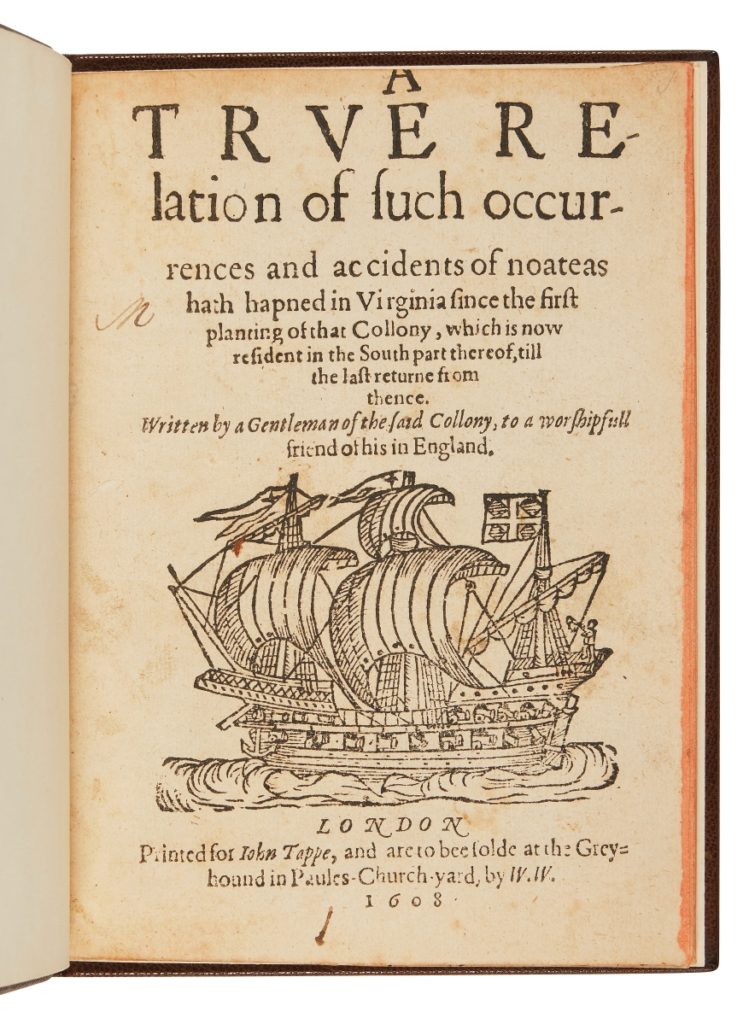
The first book on the first permanent English settlement in the Americas was also a first edition of John Smith’s first book, so perhaps it was not coincidental that his A True Relation…was also the first lot in the Fine Manuscript and Printed Americana sale. The only time this volume was on the market was in 2002, when Sotheby’s London sold it; otherwise, no other copies are known at auction. It sold to a private collector for $529,200 ($400/600,000).
Americana: Furniture, Folk Art, Silver, Chinese Export Art, Prints, Photographs, Books and Historical Documents
Offered in an online-only sale that closed on January 23 were 305 lots of American furniture, folk art, silver, Chinese export, photographs, books and historical documents. The sale earned $1,141,308, 90 percent of its low estimate; 74 percent of the lots found buyers.
Private collectors were dominant in many of the highest prices, including the sale’s top lot: James Bard’s (1815-1897) “Paddle Wheeler Steamboat Kaaterskill,” which sailed to a mid-estimate finish at $50,400.
Heading the silver category at $27,720 was a silver-gilt, enamel and jewel mounted glass jug, made for the 1893 World’s Columbian Exposition in Chicago by Gorham; it was followed by another Gorham product, a silver Japonesque two-handled tray made in 1881, which was bid to $23,940, more than twice its high estimate.
Furniture offered online was led at $18,900 by a Chippendale carved and figured mahogany marble-top sideboard table, Philadelphia, circa 1765. It was being sold by the Robert L. McNeil Jr Trust, with additional provenance to Israel Sack. A William and Mary carved, turned and joined maple and pine daybed, Philadelphia, circa 1730, with provenance to Col. Edgar William Garbisch and Bernice Chrysler Garbisch, sold to Alan Miller bidding on behalf of a client, for $5,040. Miller said it is the earliest surviving Philadelphia daybed or other seating form with a carved crest.
Several of the lots with the highest estimates failed to sell, which undoubtedly hurt the department’s bottom line.
“At the end of the day, when you have a lot of expensive things, it’s a thin market,” Erik Gronning acknowledged when we reached him by phone after the sale. “There was a lot on the market and as a result, it’s hard to know where the appetite is until you offer it. I thought estimates were in line with the reality of a few years ago. What I thought was interesting was there is [now] more focus on provincial country pieces and folky things than on formal high-style furniture.”
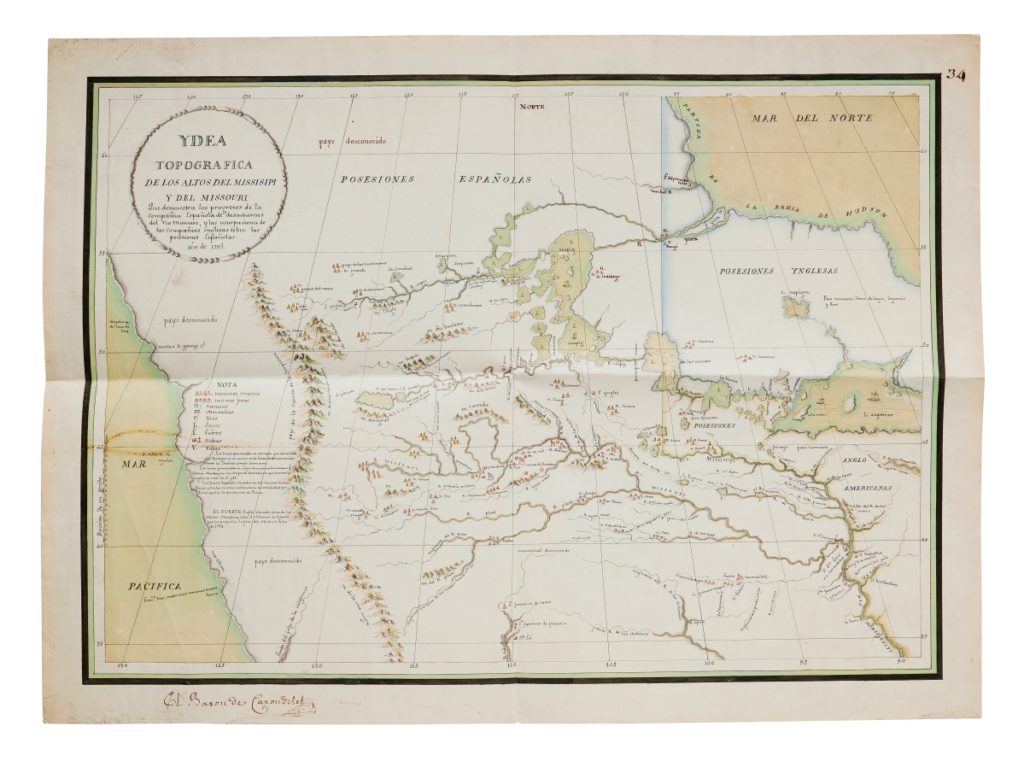
“It wasn’t a shy estimate but given its importance, we did not have any problem putting a high estimate on it,” Richard Austin said about Antoine Soulard’s manuscript map of the upper Mississippi and Missouri Rivers, which sold to a cartography collector for the week’s top price of $1,744,000. Fine Manuscript and Printed Americana ($1.5/2 million).
Fine Manuscript and Printed Americana
The highest price realized by a single lot offered in any sale during Sotheby’s Americana Week was $1,744,000, realized in the firm’s January Fine Manuscript and Printed Americana sale. The 14-lot sale tallied an impressive $3,177,880, achieving nearly 83 percent by value, though just six of the 14 lots traded successfully.
The lot that was the star of the week had good reason to warrant the top price: it was Antoine Pierre Soulard’s (1766-1825) 1795 manuscript map of the upper Mississippi and Missouri rivers, showing the expedition of the Spanish Company for exploration of the Missouri River and the encroachments of the English companies in the Spanish possessions. According to the catalog, no earlier map showed the Upper Great Plains in such precise and correct detail. Not only did it remain the only current resource on Great Plains cartography in the first decade of the Nineteenth Century but it proved an invaluable guide for William Clark and Meriwether Lewis’ 1804-06 expedition of the land newly acquired by the United States in the Louisiana Purchase.
John Smith’s A True Relation…is described in the catalog as “notoriously rare,” the “profusion of firsts,” including the volume being not only a first edition but John Smith’s first book and the first book on the first permanent English settlement in the Americas (Jamestown, Va.). The 1608 volume garnered a lot of interest, with bidders both on the phone and online but in the end, another “major private collector” prevailed, at $529,200.
The same price was achieved by a first printing in Boston’s Herald of Freedom (September 7, 1790) of George Washington’s most explicit pronouncement on religious tolerance. Written in a response to four addresses, formally written and given to Washington on his visit to Newport, R.I., in which the last of the four was from the community’s Jewish community. It predated Washington’s response that was published in the Gazette of the United States, from which the address is more widely known. Prior to the sale, Sotheby’s could find no record of another example of the printing ever being offered at auction.
“We made over $3 million in six lots, which to me is a success,” Austin said. “The prices we achieved are for true rarities. We try to focus as much attention on the lots as we could by having a small sale.”
In April, Sotheby’s will sell the Americana collection of Erving and Joyce Wolf, an assemblage that includes exemplary examples of paintings and watercolors, sculpture, early American furniture, silver, Chinese export porcelain, design and jewelry. Some of the Wolfs’ collection was on view during Americana Week to tempt buyers.
Prices quoted include the buyer’s premium as reported by the auction house. For information, www.sothebys.com or 212-606-7000.


